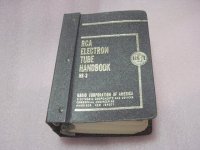I'd like to pick up one or more books of tube data so I can have that information right in front of me instead of looking up certain tubes on the interwebs. Are there any versions that should be sought out or any that should be avoided? Or are they all basically the same?
thanks
thanks
An early (1940 or so) and late (late 1960's) RCA manuals should cover most everything you need - Sylvania's '40s manuals are also good for the early tubes. GE's were a "summary" type - one or two lines of data per tube, but of course they could fit more numbers in that way...
atmars said:Are there any versions that should be sought out or any that should be avoided? Or are they all basically the same?
This will depend on just how much information you will want for any tube number. The most easily obtainable reference is probably the RCA RC-30 receiving tube manual from around 1975. It covers most all late model tubes with one set of plate curves. Older numbers are in condensed form at the back of the book along with some circuits. Sylvania also made a nice 3-ring binder type that was updateable. These may or may not be complete if you find one, but still worth having. And any old copy of the Radio Amateur's Handbook has a condensed tube spec. listing.
Much more information is available in the RCA HB-3 handbook series. This is a multi volume (5) small loose leaf, but very thick, set that provides more curves and covers receiving, industrial, transmitting, cathode ray and other special types. One such volume is shown below. These have become rare and difficult to find.
But RCA didn't make everything. To be well rounded you'll want handbooks from at least several others like Amperex, Siemens or any other European maker that you can find.
Finally many, if not all, of the once big American tube manufacturers published large loose leaf binders of tube specifications. These have become very rare, but once in a blue moon, you might find one or two on eBay for big money. Fortunately for me, I've been around long enough to have collected many of these. However I find that, for the most part, the common small tube manuals are the ones I use most.
Victor
Attachments
- Status
- Not open for further replies.
